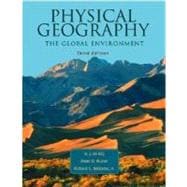
| Preface | |
| A Global Perspective | |
| Geography | |
| Physical Geography | |
| A Century of Physical Geography | |
| Systems and Models in Physical Geography | |
| Geographic Magnitude | |
| Perspectives on the Human Environment: Sliding Scale | |
| The Planet Earth | |
| Spheres of the Earth System | |
| Hemispheres | |
| Continents and Oceans | |
| Perspectives on the Human Environment: Human Population and Natural Processes | |
| Mapping the Earth''s Surface | |
| The Spherical Earth | |
| Map Projections | |
| Map Interpretation | |
| Evolving Cartographic Technology | |
| Perspectives on the Human Environment: Remote Sensing of the Environment | |
| The Earth in the Universe | |
| The Universe | |
| The Solar System | |
| Perspectives on the Human Environment: Collision! | |
| Earth-Sun Relationships | |
| Earth''s Planetary Motions | |
| Seasonality | |
| Insolation and Its Variation | |
| Perspectives on the Human Environment: Measuring Time on Our Rotating Earth | |
| Atmosphere and Hydrosphere | |
| Composition and Structure of the Atmosphere | |
| Contents of the Atmosphere | |
| The Layered Structure of the Atmosphere | |
| Research Frontiers | |
| Perspectives on the Human Environment: Ozone Holes in the Stratosphere | |
| Radiation and the Heat Balance of the Atmosphere | |
| The Radiation Balance | |
| The Heat Balance | |
| Global Distribution of Heat Flows | |
| Perspectives on the Human Environment: The Greenhouse Effect and Global Warming | |
| Atmospheric and Surface Temperature | |
| What is Temperature? | |
| The Vertical Distribution of Temperature | |
| The Horizontal Distribution of Temperature | |
| Perspectives on the Human Environment: Urban Dust Domes and Heating Patterns | |
| Air Pressure and Winds | |
| Atmospheric Pressure | |
| Air Movement in the Atmosphere | |
| Large-and Smaller-Scale Wind Systems | |
| Local Wind Systems | |
| Perspectives on the Human Environment: Air Pressure and Wind in Our Daily Lives | |
| Circulation Patterns of the Atmosphere | |
| A Model of the Surface Circulation | |
| The Actual Surface Circulation Pattern | |
| Secondary Surface Circulation: Monsoonal Windflows | |
| Circulation of the Upper Atmosphere | |
| Perspectives on the Human Environment: The Sailor''s Legacy-Naming the Winds | |
| Hydrosphere: Circulation of the World Ocean | |
| Surface Currents | |
| Generation of Ocean Currents | |
| Flow Behavior of Ocean Currents | |
| Deep-Sea Currents | |
| The Coupled Ocean-Atmosphere System | |
| El Nino-Southern Oscillation | |
| Perspectives on the Human Environment: The North Atlantic Oscillation | |
| Atmospheric Moisture and the Water Balance | |
| Physical Properties of Water | |
| Measuring Water Vapor | |
| The Hydrologic Cycle | |
| Evaporation | |
| Condensation and Clouds | |
| Precipitation | |
| The Surface Water Balance | |
| Perspectives on the Human Environment: Water Usage in the United States | |
| Precipitation, Air Masses, and Fronts | |
| Precipitation-Producing Processes | |
| Convergent-Lifting Precipitation | |
| Convectional Precipitation | |
| Orographic Precipitation | |
| Frontal (Cyclonic) Precipitation | |
| Air Masses in the Atmosphere | |
| Perspectives on the Human Environment: Tornadoes and Their Consequences | |
| Weather Systems | |
| Low-Latitude Weather Systems | |
| Weather Systems of the Middle and Higher Latitudes | |
| Energy and Moisture Within Weather Systems | |
| Perspectives on the Human Environment: Honduras After Hurricane Mitch | |
| Weather Tracking and Forecasting | |
| Weather Data Acquisition | |
| Mapping Weather Data | |
| Weather Forecasting | |
| Perspectives on the Human Environment: Weather Extremes | |
| Climate Classification and Regionalization | |
| Classifying Climates | |
| The Koppen Climate Classification System | |
| The Regional Distribution of Climate Types | |
| Boundaries of Climate Regions | |
| Perspectives on the Human Environment: Climate in Daily Human Terms | |
| Tropical (A) and Arid (B) Climates | |
| The Major Tropical (A) Climates | |
| The Major Arid (B) Climates Perspectives on the Human Environment: Deforestation of the Tropics | |
| Perspectives on the Human | |
| Table of Contents provided by Publisher. All Rights Reserved. |
The New copy of this book will include any supplemental materials advertised. Please check the title of the book to determine if it should include any access cards, study guides, lab manuals, CDs, etc.
The Used, Rental and eBook copies of this book are not guaranteed to include any supplemental materials. Typically, only the book itself is included. This is true even if the title states it includes any access cards, study guides, lab manuals, CDs, etc.